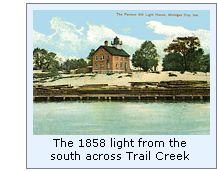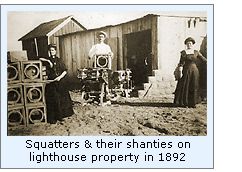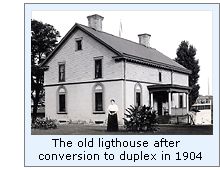By 1868, there were a number of leaks where the tower was integrated into the shingled roof, and the following year a crew arrived at the station to undertake the necessary repairs. Over the years, a number of squatters had moved onto the lighthouse property and erected ramshackle shacks in the area. It is likely that Colfax brought this to the attention of the District Inspector during his visits to the station, as the 1869 annual report contained a statement that "Measures should be taken to remove intruders who have settled upon the reservation."
 By the 1870's it was clear that the short timber piers erected some 30 years previous were wholly unsuccessful, as even with frequent dredging, the depth across the bar at the river mouth was frequently reported to be as shallow as 2 ½ feet at times, with entry still blocked to vessels except those of the shallowest draft, and the Army Corps of Engineers again returned to Michigan City to begin extending the piers at the river mouth in 1871. To guide the way between the lengthened piers, a timber frame pierhead beacon was erected on the outer end of the east pier on November 20, 1871. With the increased workload resulting from responsibility for two lights at the station, Hayward Soloman was appointed as Harriet's assistant, reporting for duty on November 29.
By the 1870's it was clear that the short timber piers erected some 30 years previous were wholly unsuccessful, as even with frequent dredging, the depth across the bar at the river mouth was frequently reported to be as shallow as 2 ½ feet at times, with entry still blocked to vessels except those of the shallowest draft, and the Army Corps of Engineers again returned to Michigan City to begin extending the piers at the river mouth in 1871. To guide the way between the lengthened piers, a timber frame pierhead beacon was erected on the outer end of the east pier on November 20, 1871. With the increased workload resulting from responsibility for two lights at the station, Hayward Soloman was appointed as Harriet's assistant, reporting for duty on November 29.
In 1880, the dwelling and outbuildings were repaired, the tower and lantern were painted, and a 320-foot wooden fence was erected around the lighthouse grounds. Two years later, sand drifts, which had built up around the station buildings were leveled, and the fence on the north and west sides was replaced with a tight board fence to serve as a wind break to help stem future drifting. A well was dug and lined with brick and connected to a hand pump in the kitchen by an iron pipe.
While Colfax had likely appreciated the five assistants who had been assigned to the station to work with her over the past ten years, the assistant's position was abolished in 1882, likely as a district cost cutting measure, and Harriet was forced to make the grueling trip out to the pierhead light twice a night to tend the light.
 By 1892, there had been little improvement in the situation with squatters on the lighthouse property, and measures were taken to evict them and their shanties were removed. Since the establishment of the original light 63 years previous, lamp oil had been stored in the cellar beneath the dwelling. However, with a change to the significantly more volatile kerosene, a number of devastating dwelling fires were experienced, and beginning late in the 1880's the Lighthouse Board began building separate oil storage buildings at all US light stations. To this end, a work crew and 6,000 bricks were delivered at the station in 1894, and a 350-gallon capacity brick oil storage building standing 7' by 12' in plan was erected 50 feet southeast of the dwelling.
By 1892, there had been little improvement in the situation with squatters on the lighthouse property, and measures were taken to evict them and their shanties were removed. Since the establishment of the original light 63 years previous, lamp oil had been stored in the cellar beneath the dwelling. However, with a change to the significantly more volatile kerosene, a number of devastating dwelling fires were experienced, and beginning late in the 1880's the Lighthouse Board began building separate oil storage buildings at all US light stations. To this end, a work crew and 6,000 bricks were delivered at the station in 1894, and a 350-gallon capacity brick oil storage building standing 7' by 12' in plan was erected 50 feet southeast of the dwelling.
With the Army Corps of Engineers engaged in constructing a breakwater on the east side of the river mouth in 1904, the Lighthouse Board began planning for the establishment of a combined first-class fog and light tower at its outer end in 1904. At 80 years of age, Harriet retired as keeper of the Michigan City Light after 43 years of faithful service to her station. Her love of the station is evident in her entry in the station log book on October 8 in which she wrote "Sold household effects preparatory to vacating dear old Lt. House." Thomas J. Armstrong, who had been serving as keeper of the South Manitou Light Station for the past ten years was transferred in as the station's new keeper, and Harriet departed her "dear" station on October 13, 1904. Harriet passed away five months later on April 16, 1905.
